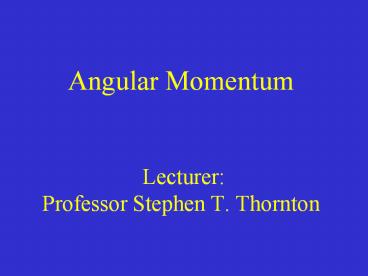Angular Momentum Lecturer: Professor Stephen T. Thornton - PowerPoint PPT Presentation
1 / 33
Title:
Angular Momentum Lecturer: Professor Stephen T. Thornton
Description:
Title: Physics 201 Author: Steve Thornton Last modified by: demolab Created Date: 8/20/2003 6:41:33 PM Document presentation format: On-screen Show (4:3) – PowerPoint PPT presentation
Number of Views:251
Avg rating:3.0/5.0
Title: Angular Momentum Lecturer: Professor Stephen T. Thornton
1
Angular Momentum Lecturer Professor Stephen
T. Thornton
2
Reading QuizCan an object moving in a straight
line ever have a nonzero angular momentum?
A) Always B) Never C) Sometimes
3
Answer C
- Sometimes, because it depends upon the axis of
rotation around which you want to find the
angular momentum. There is no angular momentum
when the object passes through the rotation axis,
because the moment arm is zero. There is angular
momentum when the moment arm is nonzero (see left
sketch).
4
Last Time
- Rotational kinetic energy
- Objects rolling energy, speed
- Rotational free-body diagram
- Rotational work
5
Today
- Angular momentum
- Vector (cross) products
- Torque again with vectors
- Unbalanced torque
6
Angular Momentum of Circular Motion
This particle has linear momentum. We can also
say it has an angular momentum with respect to a
given point, in this case the center of the
circle.
7
In the case of the particle moving around the
circle, lets look more carefully at the angular
momentum.
This is another way to determine angular
momentum.
8
The Angular Momentum of Non-Tangential Motion
9
A particle moving in any direction can have
angular momentum about any point.
10
Angular Momentum in Linear and Circular Motion
The L in each view is constant. If are
the same, then L is the same.
11
Change in angular momentum
- L I?
- ?L I??, divide by ?t
This equation looks similar to Newtons 2nd law.
It is sometimes called Newtons 2nd law for
rotation.
12
Conservation of angular momentum
- Note what happens when there is no torque. ?L
0, and angular momentum is constant.
Note similarity to conservation of linear
momentum when Fnet,ext 0.
13
Conceptual QuizA figure skater stands
on one spot on the ice (assumed frictionless) and
spins around with her arms extended. When she
pulls in her arms, how do her rotational inertia,
her angular momentum and her rotational kinetic
energy change? A) They all increase.B) They
all remain the same.C) They all decrease.D) Rot
inertia decreases, angular momentum
remains constant, and her KE increases.E) Rotatio
nal inertia and angular momentum decrease,
KE decreases.
14
Answer D
- Angular momentum must be conserved. No torque.
Rotational inertia decreases, because radius
decreases. Only D is possible. - How does KE increase?
- I goes down, ? goes up, L constant.
- But K will increase because of ?.
http//www.youtube.com/watch?vAQLtcEAG9v0
15
Vector Cross Product Torque as a Vector
The vector cross product is defined as
The direction of the cross product is defined by
a right-hand rule
16
The vector (cross) product can also be written in
determinant form
17
Some properties of the cross product
18
Conceptual QuizThe direction
of the vector cross product is along the
direction
- A)
- B)
- C)
- D)
- E)
19
Answer E
20
For a particle, the torque can be defined around
a point O
Here, is the position vector to the point of
application of force relative to O.
21
Torque can be defined as the vector product of
the position vector from the axis of rotation to
the point of action of the force with the force
itself
22
Torque
A right-hand rule gives the direction of the
torque.
23
The Right-Hand Rule for Torque
24
Yo-yo demo
torque in
torque out
O
O
25
Angular Momentum of a Particle
The angular momentum of a particle about a
specified axis (or point) is given by
26
The Right-Hand Rule for Angular Momentum
p
27
Lets do this demo!
28
Lets do this demo!
No torque L is conserved. I decreases,
therefore ? must increase.
29
A Rotational Collision Angular momentum will be
conserved here.
30
Angular Momentum of a Particle
If we take the derivative of , we find
0
Since
we have
31
Opposite Particles. Two identical particles
have equal but opposite momenta, and ,
but they are not traveling along the same line.
Show that the total angular momentum of this
system does not depend on the choice of origin.
32
Conceptual QuizWhen a large star burns up its
fuel, the gravitational force contracts it to a
small size, even a few km. This is called a
neutron star. When neutron stars rotate at high
speed, even 100 rev/sec, they are called pulsars.
They have more mass than our sun. What causes
the high rotational angular velocity?
A) Friction of gas particles B)
Conservation of angular momentum
C) The dark force D) Conservation of energy
33
Answer B
- Just like our own sun, these stars rotate about
their own axis. As gravity contracts the
particles closer and closer, the density becomes
huge. There are no torques, so angular momentum
must be conserved. LI?, so as I decreases, ?
must increase.































